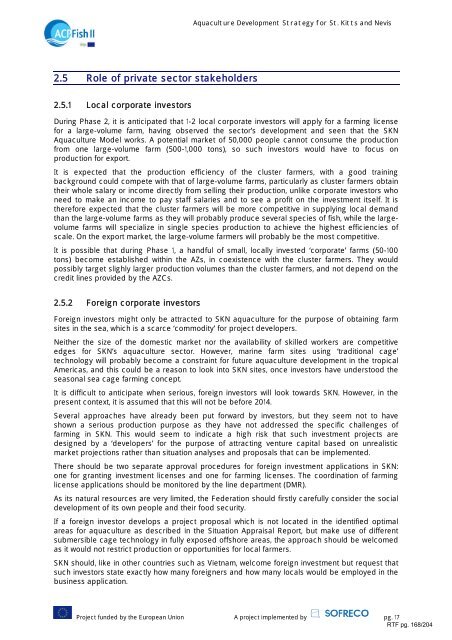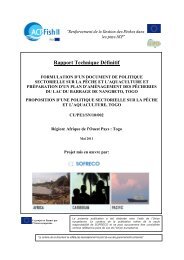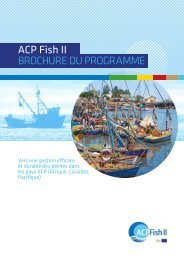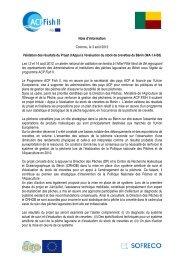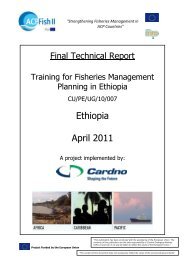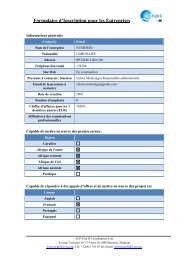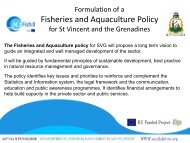Final Technical Report part 3 - ACP Fish II
Final Technical Report part 3 - ACP Fish II
Final Technical Report part 3 - ACP Fish II
Create successful ePaper yourself
Turn your PDF publications into a flip-book with our unique Google optimized e-Paper software.
Aquaculture Development Strategy for St. Kitts and Nevis2.5 Role of private sector stakeholders2.5.1 Local corporate investorsDuring Phase 2, it is anticipated that 1-2 local corporate investors will apply for a farming licensefor a large-volume farm, having observed the sector’s development and seen that the SKNAquaculture Model works. A potential market of 50,000 people cannot consume the productionfrom one large-volume farm (500-1,000 tons), so such investors would have to focus onproduction for export.It is expected that the production efficiency of the cluster farmers, with a good trainingbackground could compete with that of large-volume farms, <strong>part</strong>icularly as cluster farmers obtaintheir whole salary or income directly from selling their production, unlike corporate investors whoneed to make an income to pay staff salaries and to see a profit on the investment itself. It istherefore expected that the cluster farmers will be more competitive in supplying local demandthan the large-volume farms as they will probably produce several species of fish, while the largevolumefarms will specialize in single species production to achieve the highest efficiencies ofscale. On the export market, the large-volume farmers will probably be the most competitive.It is possible that during Phase 1, a handful of small, locally invested ‘corporate’ farms (50-100tons) become established within the AZs, in coexistence with the cluster farmers. They wouldpossibly target slighly larger production volumes than the cluster farmers, and not depend on thecredit lines provided by the AZCs.2.5.2 Foreign corporate investorsForeign investors might only be attracted to SKN aquaculture for the purpose of obtaining farmsites in the sea, which is a scarce ‘commodity’ for project developers.Neither the size of the domestic market nor the availability of skilled workers are competitiveedges for SKN’s aquaculture sector. However, marine farm sites using ‘traditional cage’technology will probably become a constraint for future aquaculture development in the tropicalAmericas, and this could be a reason to look into SKN sites, once investors have understood theseasonal sea cage farming concept.It is difficult to anticipate when serious, foreign investors will look towards SKN. However, in thepresent context, it is assumed that this will not be before 2014.Several approaches have already been put forward by investors, but they seem not to haveshown a serious production purpose as they have not addressed the specific challenges offarming in SKN. This would seem to indicate a high risk that such investment projects aredesigned by a ‘developers’ for the purpose of attracting venture capital based on unrealisticmarket projections rather than situation analyses and proposals that can be implemented.There should be two separate approval procedures for foreign investment applications in SKN:one for granting investment licenses and one for farming licenses. The coordination of farminglicense applications should be monitored by the line de<strong>part</strong>ment (DMR).As its natural resources are very limited, the Federation should firstly carefully consider the socialdevelopment of its own people and their food security.If a foreign investor develops a project proposal which is not located in the identified optimalareas for aquaculture as described in the Situation Appraisal <strong>Report</strong>, but make use of differentsubmersible cage technology in fully exposed offshore areas, the approach should be welcomedas it would not restrict production or opportunities for local farmers.SKN should, like in other countries such as Vietnam, welcome foreign investment but request thatsuch investors state exactly how many foreigners and how many locals would be employed in thebusiness application.Project funded by the European Union A project implemented by pg. 17RTF pg. 168/204


